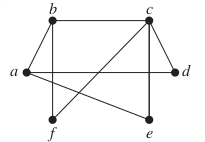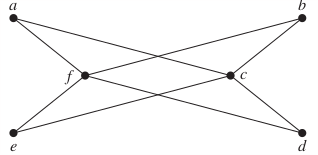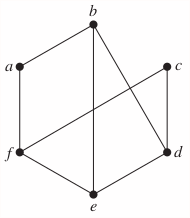10.2 Graph Terminology
p672
Homework
p687: 23, 24, 25, 52, 53, 54
In Exercises 21–25 determine whether the graph is bipartite. You may find it useful to apply Theorem 4 and answer the question by determining whether it is possible to assign either red or blue to each vertex so that no two adjacent vertices are assigned the same color.
23. 
Solution
Not bipartite.
24. 
Solution
Bipartite
25. 
Solution
Not bipartite.
52. Let G be a graph with v vertices and e edges. Let M be the maximum degree of the vertices of G, and let m be the minimum degree of the vertices of G. Show that
a) b) .
Solution
Let the th vertex be , and the degree of be .
A simple graph is called regular if every vertex of this graph has the same degree. A regular graph is called n-regular if every vertex in this graph has degree n.
53. For which values of n are these graphs regular?
a) b) c) d)
Solution
a. For , is a (n-1)-regular graph.
b. For , is a 2-regular graph.
c. For , is a 3-regular graph.
d. For , is a n-regular graph.
54. For which values of m and n is regular?
Solution
When , is regular.
64. Show that if is a bipartite simple graph with vertices and edges, then .
Solution